Nic Williams, leader of Church@Community, tells of its development in St Ann's, Nottingham. Launched in October 2010, it meets in a local primary school.
Before getting involved with Church@Community, I had been part of a local Methodist church where we were completely reviewing our practices. From that review in 2007 we realised that we were doing loads of work inside the building and lots of people were doing good work in the community as individuals but the two things didn’t really marry up at all.
 We worked on a plan and a vision as how to improve that because the church building itself wasn't situated particularly well as a community venue. One of the most deprived estates in the country was on the doorstep, at one point St Ann's was branded the gun capital of Britain, and yet there wasn't a Methodist presence at all. However, I had a good knowledge of the area because of my job as Director of Business and Community at a school there.
We worked on a plan and a vision as how to improve that because the church building itself wasn't situated particularly well as a community venue. One of the most deprived estates in the country was on the doorstep, at one point St Ann's was branded the gun capital of Britain, and yet there wasn't a Methodist presence at all. However, I had a good knowledge of the area because of my job as Director of Business and Community at a school there.
Unfortunately, time went by and the church's vision and plan for the area was put to one side. A group of about 12 of us spent a summer considering the way forward in prayer and, from that, we went to the (Nottingham East) Circuit to say we still believed the time was right to do something new for this area. The Circuit agreed and we spent some time refining the plan.
Seeing the needs of local families at first hand, I knew there was a real calling because a very limited amount of community work was going on. There were lots of faith organisations around but they were not necessarily engaging with the community. We knew that we didn't want our project to be about 'signing people up' to come to church; instead its focus was to be part of that community. We wanted to find out how we could be involved in, and support, what was already there.
At the same time there were other churches in Nottingham where God was calling people to move out and be part of the St Ann's community. It was a different vision but the same principles – God was putting all these things in place for us.
 One of our key challenges stemmed from the fact that our leadership team had been part of an established leadership of a church but we hadn't got a 'sending' church to support us in what we were doing. We looked to our Superintendent and our Circuit and received their backing – not in financial terms but their support was crucial.
One of our key challenges stemmed from the fact that our leadership team had been part of an established leadership of a church but we hadn't got a 'sending' church to support us in what we were doing. We looked to our Superintendent and our Circuit and received their backing – not in financial terms but their support was crucial.
There were also issues around money and membership because we were still members of the original church but we weren't attending it. We realised that this was a faith exercise because other people in the Circuit were saying of the new venture, 'When will they start paying into the Methodist Church?'
In my daily work, I deal with some of the most challenging families in the city so it is very satisfying to see how Church @ Community has gone from being a church-based initiative – with the original team – to it actually reflecting the community. That turnaround has happened as a result of the people who have turned up; I know the background of many of those who are now part of what's happening – and God is clearly in it.
 This is great but it can also be very hard work. Easter Sunday morning, for instance, was very challenging. A new family came along with four children, all of whom ran riot. But this is what we are here for, so that a family like that can come and feel they can be as they really are. It may be uncomfortable for the rest of us but that's the way it is when you really begin to deal with people outside the communities we're familiar with.
This is great but it can also be very hard work. Easter Sunday morning, for instance, was very challenging. A new family came along with four children, all of whom ran riot. But this is what we are here for, so that a family like that can come and feel they can be as they really are. It may be uncomfortable for the rest of us but that's the way it is when you really begin to deal with people outside the communities we're familiar with.
We meet in the main hall of the school where I work, Blue Bell Hill Primary School, on the second, fourth and fifth Sundays of the month. It all starts from about 10am to 12noon and it's very relaxed. Tea, coffee and cake are served all the time and everyone sits around tables. We have a live worship band which includes a singer, two guitarists and a five-year-old drummer on a full-sized kit!
 I lead the worship and we sometimes have a local preacher or it's just led by the team. We usually have 15 minutes of singing which lead into a time where children (and adults) act out a Bible story all based around a theme. Then we have a ten minute break – a sort of 'interval' – and we always have a craft activity to create something to take home. The following week we always ask, 'What have you done with what you made? Have you used it for prayer? If so, how?'
I lead the worship and we sometimes have a local preacher or it's just led by the team. We usually have 15 minutes of singing which lead into a time where children (and adults) act out a Bible story all based around a theme. Then we have a ten minute break – a sort of 'interval' – and we always have a craft activity to create something to take home. The following week we always ask, 'What have you done with what you made? Have you used it for prayer? If so, how?'
It's not everyone's cup of tea but we range between 50 and 70 in number and at Christmas we reached 95. Our oldest member is 90. We get a community grant so are classified as a community organisation and this can bring about a different attitude to what we do. In our first year the Lord Mayor came to our civic carol service during his Christmas round of events. The community police officers, if they are on the beat that day, will also sit in the school hall with us during our time together, be part of it all and have their surgeries there. The hall is very big so people can just mingle at the back.
 We're very clearly identifiable now as Church @ Community because we all wear blue polo shirts; the community call us the Blue Shirt Brigade! At first it was just the leaders wearing the shirts or badges; now I'd say nearly 70% of our regulars have got Church @ Community hoodies or polo shirts. When we started I suggested that every time there was any sort of local event we needed to be there. We spent a long time 'investing' in things and, as a result, the local councillors got to know who we were.
We're very clearly identifiable now as Church @ Community because we all wear blue polo shirts; the community call us the Blue Shirt Brigade! At first it was just the leaders wearing the shirts or badges; now I'd say nearly 70% of our regulars have got Church @ Community hoodies or polo shirts. When we started I suggested that every time there was any sort of local event we needed to be there. We spent a long time 'investing' in things and, as a result, the local councillors got to know who we were.
We have been greatly helped by Rob Cotton of the Bible Society who has worked alongside us to ask difficult questions along the way, such as, 'Where are the people at Church @ Community getting their spirituality?' I believe people are getting that spirituality from being part of a community, by being part of a group, because there is a lot of spirituality there. At some stage the time will be right for us to do the small group thing; it will come if people ask for it but we will not set up a group just for the sake of it. That is not going to happen.
There are 11 of us in the leadership team, all non-ministerial. Our support comes from the Superintendent, I meet with him every month for accountability and once a quarter we hold a team leadership meeting; we also have mini meetings.
 We recently got to the point of asking, 'How is this going to go forward?' I told the whole church that the vision needs to be everybody's, I am happy to play my part but I can't do it all, I can only do so much. They needed to know that it now needs to be them taking it forward. We are encouraging everyone to contribute to it in some way and we have already seen a men's breakfast being started in a local pub and cake and coffee mornings.
We recently got to the point of asking, 'How is this going to go forward?' I told the whole church that the vision needs to be everybody's, I am happy to play my part but I can't do it all, I can only do so much. They needed to know that it now needs to be them taking it forward. We are encouraging everyone to contribute to it in some way and we have already seen a men's breakfast being started in a local pub and cake and coffee mornings.
Great things have happened at Church @ Community. We have had a baptism and one of the governors of the school has also asked for her child to be baptised – and will be bringing 80 people along to the occasion. Twice a quarter we have a communion service when the elements are blessed by a minister. Then people come up to collect the bread and wine and share it with their own table.
A key challenge at the moment is the financial implications of all of this. From day one the church has been totally funded by the leadership team but we don't have the finance to keep on bankrolling the church. Not having premises to uphold means we have got the freedom to do things differently; that's great but there are lots of other things to consider.
 We have just had quite wide-ranging discussions with our Superintendent about this and agreed that we will explore the possibility of becoming a bona-fide, 'official', church in September. The fear is, 'Are we going to become the same as a traditional church?'
We have just had quite wide-ranging discussions with our Superintendent about this and agreed that we will explore the possibility of becoming a bona-fide, 'official', church in September. The fear is, 'Are we going to become the same as a traditional church?'
That's why we will go back to the Circuit to discuss things like, 'What will our financial commitment be as we have one of the biggest congregations in the Circuit? This is a fresh expression, how is the Circuit going to support this?' So far it is all looking positive and if God wants it to be this way, all will be well. It is a leap of faith. If people choose to become a member of the Methodist Church with us they can – but they don't have to.
If local preachers start to become involved, they need to be briefed really well. They won't be 'leading' full services as such; they will have a five minute slot to give a short sermon, working alongside the worship team to deliver the rest of the service. For a lot of people that's hard. We have to explain that it's important to be prepared to change everything at the last minute because flexibility is key here.
 I think there is an understanding of fresh expressions within Church @ Community but I presently don't put the Methodist stamp on it. I know I'm Methodist but does it really matter? Me putting up a big sign is not going to make people in our community come to us. Methodism was originally all about going out and starting new things and that's what I see with Church@Community. It's also important to remain flexible in approach. We keep on asking what people in the community want, and we have changed as a result.
I think there is an understanding of fresh expressions within Church @ Community but I presently don't put the Methodist stamp on it. I know I'm Methodist but does it really matter? Me putting up a big sign is not going to make people in our community come to us. Methodism was originally all about going out and starting new things and that's what I see with Church@Community. It's also important to remain flexible in approach. We keep on asking what people in the community want, and we have changed as a result.
Does it really matter? We know as an organisation that we are Methodist, that's our background, but we don't need to shout about it. It is important for me to work alongside other denominations in the area.
 If we stick to our values of being part of the community and not just keep focusing on Sunday services and work with other organisations, things will happen. Two things stand out for me:
If we stick to our values of being part of the community and not just keep focusing on Sunday services and work with other organisations, things will happen. Two things stand out for me:
- Street Pastors in Nottingham City Centre were looking at where to expand their programme and we were one of the first organisations they came to;
- Citizens UK have just come to Nottingham; they approached us to ask if I could go on their community team. That wouldn’t have happened for St Ann's if I wasn't there.
The danger is that people may think of us as just another branch of the social services rather than a church but we couldn’t be clearer about the roots of all we do. Even our Family Funday had a service as part of what was a Pentecost event, I was amazed so many people came to it but it's all part of God's plan.
 This programme, with a strong Christian emphasis, was geared for families and encouraged the building up of the local community in a caring environment. Sadly we have lost touch with some families because of the earthquakes we suffered here in September 2010 and February 2011. Many people left Christchurch as a result and others went because of housing problems.
This programme, with a strong Christian emphasis, was geared for families and encouraged the building up of the local community in a caring environment. Sadly we have lost touch with some families because of the earthquakes we suffered here in September 2010 and February 2011. Many people left Christchurch as a result and others went because of housing problems.

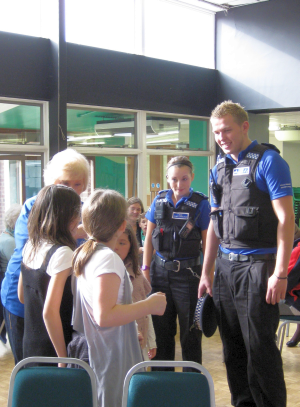
 We worked on a plan and a vision as how to improve that because the church building itself wasn't situated particularly well as a community venue. One of the most deprived estates in the country was on the doorstep, at one point St Ann's was branded the gun capital of Britain, and yet there wasn't a Methodist presence at all. However, I had a good knowledge of the area because of my job as Director of Business and Community at a school there.
We worked on a plan and a vision as how to improve that because the church building itself wasn't situated particularly well as a community venue. One of the most deprived estates in the country was on the doorstep, at one point St Ann's was branded the gun capital of Britain, and yet there wasn't a Methodist presence at all. However, I had a good knowledge of the area because of my job as Director of Business and Community at a school there. One of our key challenges stemmed from the fact that our leadership team had been part of an established leadership of a church but we hadn't got a 'sending' church to support us in what we were doing. We looked to our Superintendent and our Circuit and received their backing – not in financial terms but their support was crucial.
One of our key challenges stemmed from the fact that our leadership team had been part of an established leadership of a church but we hadn't got a 'sending' church to support us in what we were doing. We looked to our Superintendent and our Circuit and received their backing – not in financial terms but their support was crucial. This is great but it can also be very hard work. Easter Sunday morning, for instance, was very challenging. A new family came along with four children, all of whom ran riot. But this is what we are here for, so that a family like that can come and feel they can be as they really are. It may be uncomfortable for the rest of us but that's the way it is when you really begin to deal with people outside the communities we're familiar with.
This is great but it can also be very hard work. Easter Sunday morning, for instance, was very challenging. A new family came along with four children, all of whom ran riot. But this is what we are here for, so that a family like that can come and feel they can be as they really are. It may be uncomfortable for the rest of us but that's the way it is when you really begin to deal with people outside the communities we're familiar with. I lead the worship and we sometimes have a local preacher or it's just led by the team. We usually have 15 minutes of singing which lead into a time where children (and adults) act out a Bible story all based around a theme. Then we have a ten minute break – a sort of 'interval' – and we always have a craft activity to create something to take home. The following week we always ask, 'What have you done with what you made? Have you used it for prayer? If so, how?'
I lead the worship and we sometimes have a local preacher or it's just led by the team. We usually have 15 minutes of singing which lead into a time where children (and adults) act out a Bible story all based around a theme. Then we have a ten minute break – a sort of 'interval' – and we always have a craft activity to create something to take home. The following week we always ask, 'What have you done with what you made? Have you used it for prayer? If so, how?' We're very clearly identifiable now as Church @ Community because we all wear blue polo shirts; the community call us the Blue Shirt Brigade! At first it was just the leaders wearing the shirts or badges; now I'd say nearly 70% of our regulars have got Church @ Community hoodies or polo shirts. When we started I suggested that every time there was any sort of local event we needed to be there. We spent a long time 'investing' in things and, as a result, the local councillors got to know who we were.
We're very clearly identifiable now as Church @ Community because we all wear blue polo shirts; the community call us the Blue Shirt Brigade! At first it was just the leaders wearing the shirts or badges; now I'd say nearly 70% of our regulars have got Church @ Community hoodies or polo shirts. When we started I suggested that every time there was any sort of local event we needed to be there. We spent a long time 'investing' in things and, as a result, the local councillors got to know who we were. We recently got to the point of asking, 'How is this going to go forward?' I told the whole church that the vision needs to be everybody's, I am happy to play my part but I can't do it all, I can only do so much. They needed to know that it now needs to be them taking it forward. We are encouraging everyone to contribute to it in some way and we have already seen a men's breakfast being started in a local pub and cake and coffee mornings.
We recently got to the point of asking, 'How is this going to go forward?' I told the whole church that the vision needs to be everybody's, I am happy to play my part but I can't do it all, I can only do so much. They needed to know that it now needs to be them taking it forward. We are encouraging everyone to contribute to it in some way and we have already seen a men's breakfast being started in a local pub and cake and coffee mornings. We have just had quite wide-ranging discussions with our Superintendent about this and agreed that we will explore the possibility of becoming a bona-fide, 'official', church in September. The fear is, 'Are we going to become the same as a traditional church?'
We have just had quite wide-ranging discussions with our Superintendent about this and agreed that we will explore the possibility of becoming a bona-fide, 'official', church in September. The fear is, 'Are we going to become the same as a traditional church?' I think there is an understanding of fresh expressions within Church @ Community but I presently don't put the Methodist stamp on it. I know I'm Methodist but does it really matter? Me putting up a big sign is not going to make people in our community come to us. Methodism was originally all about going out and starting new things and that's what I see with Church@Community. It's also important to remain flexible in approach. We keep on asking what people in the community want, and we have changed as a result.
I think there is an understanding of fresh expressions within Church @ Community but I presently don't put the Methodist stamp on it. I know I'm Methodist but does it really matter? Me putting up a big sign is not going to make people in our community come to us. Methodism was originally all about going out and starting new things and that's what I see with Church@Community. It's also important to remain flexible in approach. We keep on asking what people in the community want, and we have changed as a result. If we stick to our values of being part of the community and not just keep focusing on Sunday services and work with other organisations, things will happen. Two things stand out for me:
If we stick to our values of being part of the community and not just keep focusing on Sunday services and work with other organisations, things will happen. Two things stand out for me:
 Tim Carter asks whether Anglicanism must die.
Tim Carter asks whether Anglicanism must die.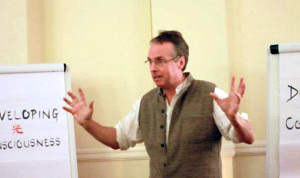
 Attending the introductory 'Developing Consciousness Course'.
Attending the introductory 'Developing Consciousness Course'.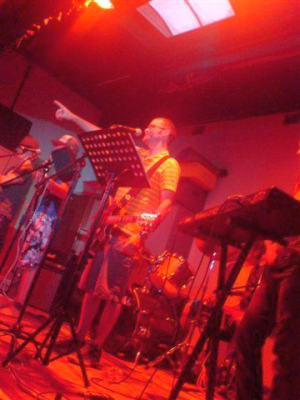
 I often struggled to find the Jesus I'd met in the guitar shop when I was in a church; the worlds seemed so far apart. I've been involved youth work and youth ministry training for about 14 years but I've always been more interested in the people 'out there' rather than those on the 'inside'.
I often struggled to find the Jesus I'd met in the guitar shop when I was in a church; the worlds seemed so far apart. I've been involved youth work and youth ministry training for about 14 years but I've always been more interested in the people 'out there' rather than those on the 'inside'. The name, Mighty Shed, comes from my home studio, which is housed… in a shed. The Bible says that 'people look at the outside of a person but God looks at the heart' and we know that significant things can come out of something that looks very small and understated, like a shed. In the same way, we believe people are full of potential – we are all mighty sheds!
The name, Mighty Shed, comes from my home studio, which is housed… in a shed. The Bible says that 'people look at the outside of a person but God looks at the heart' and we know that significant things can come out of something that looks very small and understated, like a shed. In the same way, we believe people are full of potential – we are all mighty sheds! 1. A community church for young people, made up of two groups – Xplosion (for school years 6-9) and the Big Bang (for school years 10 and upwards). The Big Bang, as the older group, 'owns' and runs the Xplosion younger group; it also has an investment in maintaining itself and the younger group through participation and empowerment which helps to develop young leaders. At the moment, the total turnout is around 35-45 plus 'grown-ups'. Alongside this I have spent a lot of time in primary school work and found it invaluable in investing in local community and young people – particularly if you are looking to set up something for the long-term.
1. A community church for young people, made up of two groups – Xplosion (for school years 6-9) and the Big Bang (for school years 10 and upwards). The Big Bang, as the older group, 'owns' and runs the Xplosion younger group; it also has an investment in maintaining itself and the younger group through participation and empowerment which helps to develop young leaders. At the moment, the total turnout is around 35-45 plus 'grown-ups'. Alongside this I have spent a lot of time in primary school work and found it invaluable in investing in local community and young people – particularly if you are looking to set up something for the long-term. We've been meeting with a small bunch of young people in a local coffee house to plan, pray and lay the foundations for all of this. In March, we had an amazing launch gig with an internationally renowned musician performing and running workshops. Off the back of that we've set-up Facebook pages and a website and run workshops. We are now planning more gigs that look to raise money for local causes and give creative opportunities for other young people.
We've been meeting with a small bunch of young people in a local coffee house to plan, pray and lay the foundations for all of this. In March, we had an amazing launch gig with an internationally renowned musician performing and running workshops. Off the back of that we've set-up Facebook pages and a website and run workshops. We are now planning more gigs that look to raise money for local causes and give creative opportunities for other young people. In terms of context, Uplyme and Lyme Regis have a huge population in the summer and a comparatively small one in the winter. There is quite a lot of seasonal work so, if you are a young person, available employment is often through service industries. In general it's a very prosperous area but, like all places, there's more to it if you dig a little deeper.
In terms of context, Uplyme and Lyme Regis have a huge population in the summer and a comparatively small one in the winter. There is quite a lot of seasonal work so, if you are a young person, available employment is often through service industries. In general it's a very prosperous area but, like all places, there's more to it if you dig a little deeper. At the moment, there is a meeting at least once a week of youth church or Mighty Shed in some form or another. Over time I would like to draw together these two strands so that they can feed each other.
At the moment, there is a meeting at least once a week of youth church or Mighty Shed in some form or another. Over time I would like to draw together these two strands so that they can feed each other.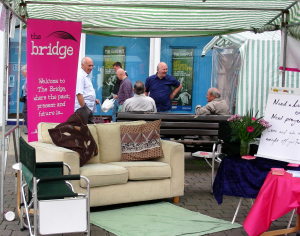

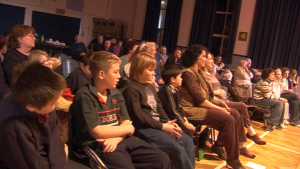
 The Bridge's worship time does take place on a Sunday, between the hours of 5 and 7. People will often come and they are surprised by how traditional it can be. We do make use of worship songs and we make use of what we call performance or presentation songs – it will involve the children right at the very beginning which often can be pretty wacky and pretty lively, they then leave for their own activities and we go into a time where we begin to look at a particular issue and focus on what the bible might be saying about something.
The Bridge's worship time does take place on a Sunday, between the hours of 5 and 7. People will often come and they are surprised by how traditional it can be. We do make use of worship songs and we make use of what we call performance or presentation songs – it will involve the children right at the very beginning which often can be pretty wacky and pretty lively, they then leave for their own activities and we go into a time where we begin to look at a particular issue and focus on what the bible might be saying about something. We have been blessed beyond our wildest dreams by the Hinckley Methodist Circuit and its commitment to The Bridge, not only in terms of finances but also in terms of staffing.
We have been blessed beyond our wildest dreams by the Hinckley Methodist Circuit and its commitment to The Bridge, not only in terms of finances but also in terms of staffing. People sometimes ask, where does your church meet? When people now ask me that question I will think about the social worker who perhaps will be dealing with a very difficult child on a Wednesday afternoon, the person who is a gardener… there is no divide between what we claim to practice on a Sunday and what we live out during the rest of the week.
People sometimes ask, where does your church meet? When people now ask me that question I will think about the social worker who perhaps will be dealing with a very difficult child on a Wednesday afternoon, the person who is a gardener… there is no divide between what we claim to practice on a Sunday and what we live out during the rest of the week.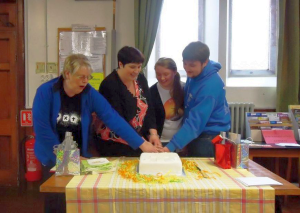
 The crowd then sang 'To God be the Glory' and prayers were said with the laying on of hands for a fresh outpouring of God's Holy Spirit. The newly-drenched quartet rushed home to shower and change as everyone else made their way to the Methodist Church Hall for hot drinks and cake.
The crowd then sang 'To God be the Glory' and prayers were said with the laying on of hands for a fresh outpouring of God's Holy Spirit. The newly-drenched quartet rushed home to shower and change as everyone else made their way to the Methodist Church Hall for hot drinks and cake. Those being baptised were two 18-year-olds who gave their lives to the Lord at Soul Survivor last year and the other two adults are also closely involved in what we do with X-treme. I was thrilled to be part of it and amazed to see what God had done. At one point it all seemed very different because, after three years of doing the project, no-one had been saved. I told God that I longed to see just one person come to faith and then we went to Soul Survivor and nine people made commitments!
Those being baptised were two 18-year-olds who gave their lives to the Lord at Soul Survivor last year and the other two adults are also closely involved in what we do with X-treme. I was thrilled to be part of it and amazed to see what God had done. At one point it all seemed very different because, after three years of doing the project, no-one had been saved. I told God that I longed to see just one person come to faith and then we went to Soul Survivor and nine people made commitments!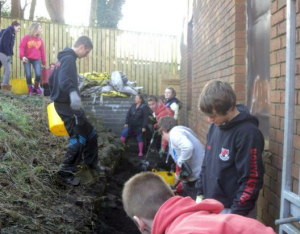
 Like many chapels it dwindled but about three years ago we had an opportunity to apply for funding from the Welsh Government to improve the overgrown and rubbish-strewn area behind the chapel to make a training garden. This would be used to encourage people in our relatively deprived area to grow their own vegetables and improve their diets.
Like many chapels it dwindled but about three years ago we had an opportunity to apply for funding from the Welsh Government to improve the overgrown and rubbish-strewn area behind the chapel to make a training garden. This would be used to encourage people in our relatively deprived area to grow their own vegetables and improve their diets. There are not many of us – we make double figures on a good day – but we're beginning to be approached about hosting community events. These include a performance of short plays written by the school pupils, a craft evening, a community archive evening and a 'visioning workshop' by the Transition Swansea organisation. We hope we might also become an outlet for the Trussell Trust food bank.
There are not many of us – we make double figures on a good day – but we're beginning to be approached about hosting community events. These include a performance of short plays written by the school pupils, a craft evening, a community archive evening and a 'visioning workshop' by the Transition Swansea organisation. We hope we might also become an outlet for the Trussell Trust food bank. The result might be a classed as a 'para church'. As someone who spent a considerable part of my ministry in what used to be called 'Industrial Mission', I am reminded of the work of Ted Wickham as Industrial Chaplain in the Diocese of Sheffield many years ago. The then-Bishop of Sheffield, Leslie Hunter, had appointed Ted Wickham to further the Bishop's "vision of a revitalised Church and a Church re-established among the industrial working class."
The result might be a classed as a 'para church'. As someone who spent a considerable part of my ministry in what used to be called 'Industrial Mission', I am reminded of the work of Ted Wickham as Industrial Chaplain in the Diocese of Sheffield many years ago. The then-Bishop of Sheffield, Leslie Hunter, had appointed Ted Wickham to further the Bishop's "vision of a revitalised Church and a Church re-established among the industrial working class."